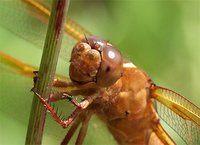Odonata
|
|
| Odonata | ||||||||
|---|---|---|---|---|---|---|---|---|
 Dragonfly, Orthetrum cancellatum | ||||||||
| Scientific classification | ||||||||
| ||||||||
| Suborders | ||||||||
|
Anisoptera (dragonflies) |
Odonata is an order in the class Insecta, encompassing those insects commonly known as dragonflies (either when referring to the group as a whole or for the species in the suborder Anisoptera) and damselflies (for the species in the suborder Zygoptera). The term Odonate has been coined to provide an English name for the group as a whole, in an attempt to resolve the problem caused by the dual meaning of the term dragonfly. This term is not however in common usage, and instead most Odonata enthusiasts solve the problem by using the term true dragonfly when referring to just the Anisoptera.
These insects characteristically have large rounded heads covered mostly by well-developed, faceted eyes, legs that facilitate catching prey (other insects) in flight, two pairs of long, transparent wings that move independently, and elongated abdomens. Although generally fairly similar, dragonflies differ from damselflies in several, easily recognizable traits. Dragonflies are strong fliers with fairly robust bodies and at rest hold their wings either out to the side or out and downward (or even somewhat forward). Damselflies tend to be less robust, even rather weak appearing in flight, and when at rest most species hold their wings folded back over the abdomen (see photograph below, left). Dragonfly eyes occupy much of the animal's head, touching (or nearly touching) each other across the face. In damselflies, there is typically a gap between the eyes.Odonates are aquatic or semi-aquatic as juveniles. Thus, adults are most often seen near bodies of water and are frequently described as aquatic insects. However, many species range far from water, seeking open fields and hilltops where they prey on smaller insects, catching these in flight. Dragonflies in particular are the raptors of the insect world and absolute masters of maneuverings in flight.
Eggs are laid in water or on vegetation near water or wet places, and hatch to produce nymphs that become (in most species) voracious predators on other aquatic organisms, including small fishes. The nymphs grow and transform into the adult flying insect. Male odonates have an organ near the back of the thorax in which they store spermatozoa; they mate by holding the female behind the head with claspers located at the tip of the male abdomen; the female bends her abdomen forward to touch the male organ and receive sperm.
Some very large species have been found in fossils. The largest odonates extant in the world today are the giant Central American damselfly, Megaloprepus coerulatusa and Anax strenuus, a Hawaiian endemic dragonfly.


